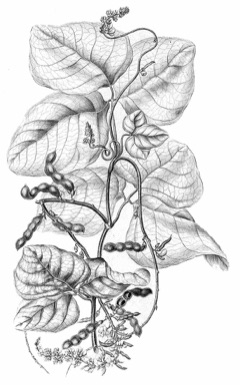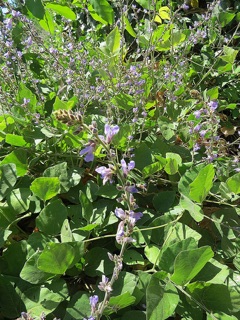 |
|
edibleplants.org |
 |
| Dick Culbert flickr.com/people/92252798@N07 |
Translate this page:
Summary
Physical Characteristics

 Calopogonium caeruleum is an evergreen Climber growing to 5 m (16ft) by 0.3 m (1ft in) at a fast rate.
Calopogonium caeruleum is an evergreen Climber growing to 5 m (16ft) by 0.3 m (1ft in) at a fast rate.
See above for USDA hardiness. It is hardy to UK zone 10. The flowers are pollinated by Insects.
It can fix Nitrogen.
Suitable for: light (sandy), medium (loamy) and heavy (clay) soils, prefers well-drained soil and can grow in nutritionally poor soil. Suitable pH: mildly acid, neutral and basic (mildly alkaline) soils and can grow in very acid soils.
It can grow in full shade (deep woodland) semi-shade (light woodland) or no shade. It prefers moist soil.
UK Hardiness Map
US Hardiness Map
Synonyms
Stenolobium caeruleum Benth.
Plant Habitats
Edible Uses
References More on Edible Uses
Medicinal Uses
Plants For A Future can not take any responsibility for any adverse effects from the use of plants. Always seek advice from a professional before using a plant medicinally.
None known
References More on Medicinal Uses
The Bookshop: Edible Plant Books
Our Latest books on Perennial Plants For Food Forests and Permaculture Gardens in paperback or digital formats.

Edible Tropical Plants
Food Forest Plants for Hotter Conditions: 250+ Plants For Tropical Food Forests & Permaculture Gardens.
More

Edible Temperate Plants
Plants for Your Food Forest: 500 Plants for Temperate Food Forests & Permaculture Gardens.
More

More Books
PFAF have eight books available in paperback and digital formats. Browse the shop for more information.
Shop Now
Other Uses
Fodder Green manure Mulch Soap Soil conditioner
Agroforestry Uses: Plants can be grown as a green manure crop. The plant gives good soil cover; builds up soil fertility through its leaf fall and nitrogen production; and can be used to smother weeds such as Imperata cylindrica[310 , 415 ]. It is grown in plantations where it can be fully productive in full sun and up to 40% shade, it grows well in mature coconut plantations where there is 30 - 40% shade, and will still do fairly well in heavy shade[415 ]. Will grow productively in mature coconut plantations (60-70% PAR ). One of the most productive herbaceous legumes, generally producing yields of 3-7 t/ha/year DM. Produced DM yields of 1-1.5 t/ha/year under mature oil palm (10% light transmission), out yielding a wide range of common herbaceous legumes. As a green manure crop/mulch , leaf fall from uncut C. caeruleum can be as high as 7 t/ha/year DM. In Nigeria, it had the second highest green manure effect on maize yield among 12 legumes tested, providing an N equivalent of about 90 kg/ha.Companion species. Legumes: Planted as a cover crop in southeast Asian plantation agriculture, often in a species mixture with one or more of the species C. mucunoides , Centrosema molle , Pueraria phaseoloides and Desmodium ovalifolium . Other Uses: The plant is used by laundresses in El Salvador to take dirt out of clothes whilst rubbing them[46 ].
Special Uses
Carbon Farming Food Forest Nitrogen Fixer
References More on Other Uses
Cultivation details
Agroforestry Services: Nitrogen Agroforestry Services: Understory legume Fodder: Pasture Management: Fodder Minor Global Crop
The plant is adapted to the humid tropics but it is fairly drought-tolerant[310 ]. It grows better in cooler conditions than centro (Centrosema pubescens) and in the elevated tropics can grow up to an altitude of about 800 metres[310 ]. Succeeds in most soils if they are well drained[310 ]. Plants are very tolerant of shading[310 ]. Plants can succeed in acid soils with a pH as low as 4.0[310 ]. It grows best in areas with a mean annual rainfall of 1,000 - 3,000mm, but will persist in environments with as little as 700mm[415 ]. It prefers environments with 25c maximum and 18c minimum day temperatures, with outer limits of 32c maximum and 10c minimum[415 ]. It has been widely planted throughout the humid tropics, and has escaped from cultivation and become naturalised in many areas[415 ]. It has considerable weed potential, often smothering desirable grasses and other understorey species[415 ]. It has invaded seasonally wet tropical environments[415 ]. When growing in the humid tropics it flowers indeterminately through the first wet season, producing seed into the dry season[415 ]. It is capable of producing moderate amounts of seed even in its first year[415 ]. This species has a symbiotic relationship with certain soil bacteria, these bacteria form nodules on the roots and fix atmospheric nitrogen. Some of this nitrogen is utilized by the growing plant but some can also be used by other plants growing nearby[200 ].
Carbon Farming
-
Agroforestry Services: Nitrogen
Plants that contribute to nitrogen fixation include the legume family – Fabaceae.
-
Agroforestry Services: Understory legume
Legume vegetation, especially the trees and shrubs growing between the forest canopy and the forest floor.
-
Fodder: Pasture
Enclosed tracts of farmland mainly of grasses, with an interspersion of legumes and other forbs (non-grass herbaceous plants).
-
Management: Fodder
Non-destructive management systems maintaining the soil organic carbon.
-
Minor Global Crop
These crops are already grown or traded around the world, but on a smaller scale than the global perennial staple and industrial crops, The annual value of a minor global crop is under $1 billion US. Examples include shea, carob, Brazil nuts and fibers such as ramie and sisal.
References Carbon Farming Information and Carbon Sequestration Information
Temperature Converter
Type a value in the Celsius field to convert the value to Fahrenheit:
Fahrenheit:
The PFAF Bookshop
Plants For A Future have a number of books available in paperback and digital form. Book titles include Edible Plants, Edible Perennials, Edible Trees,Edible Shrubs, Woodland Gardening, and Temperate Food Forest Plants. Our new book is Food Forest Plants For Hotter Conditions (Tropical and Sub-Tropical).
Shop Now
Plant Propagation
Seed - Usually established from seed, sowing into a cultivated seedbed at the beginning of the wet season. Establishment can be slow and may be improved by addition of P fertiliser and lime, and by controlling weeds. Current recommendations for cover crop under oil palm in southeast Asia are to seed C. caeruleum and Pueraria phaseoloides at 1-1.5 and 5-7.5 kg/ha seed, respectively. Can be established by stem cuttings but low success rates (5% of cuttings) are common. Using older stem material and treating stems with root-promoting hormones can improve success rates. Slower to establish than C. mucunoides and Pueraria phaseoloides and may take 20 months to achieve a complete cover. As a green manure crop, can be established by broadcasting into upland rice following the final weeding. Mid-season plantings may reduce rice yields[415 ].
Other Names
If available other names are mentioned here
Cudzu criollo, Jicama de monte, Jiquima dulce, Lamdau lam
Native Range
NORTHERN AMERICA: Mexico, San Luis Potosí, Chiapas, Colima, Guerrero, Jalisco, México, Michoacán de Ocampo, Nayarit, Oaxaca, Puebla, Querétaro, Tabasco, Veracruz de Ignacio de la Llave, Yucatán, SOUTHERN AMERICA: Hispaniola, Cuba, Trinidad and Tobago, United States, Puerto Rico, St. Vincent and Grenadines, Saint Vincent, Belize, Costa Rica, Guatemala, Honduras, Nicaragua, Panama, El Salvador, French Guiana, Guyana, Suriname, Venezuela, Brazil, Colombia, Ecuador, Peru, Argentina, Misiones, Paraguay,
Weed Potential
Right plant wrong place. We are currently updating this section.
Please note that a plant may be invasive in one area but may not in your area so it's worth checking.
Considerable weed potential. Weed of tropical plantation crops, often smothering desirable grasses and other understorey species. Has invaded seasonally wet tropical environments.
Conservation Status
IUCN Red List of Threatened Plants Status :

Growth: S = slow M = medium F = fast. Soil: L = light (sandy) M = medium H = heavy (clay). pH: A = acid N = neutral B = basic (alkaline). Shade: F = full shade S = semi-shade N = no shade. Moisture: D = dry M = Moist We = wet Wa = water.
Now available:
Food Forest Plants for Mediterranean Conditions
350+ Perennial Plants For Mediterranean and Drier Food Forests and Permaculture Gardens.
[Paperback and eBook]
This is the third in Plants For A Future's series of plant guides for food forests tailored to
specific climate zones. Following volumes on temperate and tropical ecosystems, this book focuses
on species suited to Mediterranean conditions—regions with hot, dry summers and cool, wet winters,
often facing the added challenge of climate change.
Read More
Expert comment
Author
(Benth.) Sauv.
Botanical References
Links / References
For a list of references used on this page please go here
A special thanks to Ken Fern for some of the information used on this page.
Readers comment
| Add a comment |
|
If you have important information about this plant that may help other users please add a comment or link below. Only comments or links that are felt to be directly relevant to a plant will be included. If you think a comment/link or information contained on this page is inaccurate or misleading we would welcome your feedback at [email protected]. If you have questions about a plant please use the Forum on this website as we do not have the resources to answer questions ourselves.
* Please note: the comments by website users are not necessarily those held by PFAF and may give misleading or inaccurate information.
To leave a comment please Register or login here All comments need to be approved so will not appear immediately.
|
Subject : Calopogonium caeruleum
|
|
|
|